Siege of Louisbourg (1745)
The Siege of Louisbourg took place in 1745 when a New England colonial force aided by a British fleet captured Louisbourg, the capital of the French province of Île-Royale (present-day Cape Breton Island) during the War of the Austrian Succession, known as King George's War in the British colonies.
Louisbourg was a standing menace to all the Northern British colonies. It was such a haunt of privateers that it was called the American Dunkirk. The French and the Wabanaki Confederacy continuously attacked Northern New England in numerous Northeast Coast Campaigns (See the Northeast Coast Campaigns 1688, 1703, 1723, 1724). The Fortress also commanded the chief entrance of Canada, and threatened to ruin the fisheries, which were nearly as vital to New England as was the fur-trade to New France. The French government had spent twenty-five years in fortifying it, and the cost of its defenses was reckoned at thirty million livres.[3]
Although the Fortress of Louisbourg's construction and layout was acknowledged as having superior seaward defences, a series of low rises behind them made the Fortress vulnerable to a land-attack. The low rises provided attackers places to erect siege batteries. The fort's garrison was poorly paid and supplied, and its inexperienced leaders mistrusted them. The colonial attackers were also lacking in experience, but ultimately succeeded in gaining control of the surrounding defences. The defenders surrendered in the face of an imminent assault.
Louisbourg was an important bargaining chip in the peace negotiations to end the war, since it represented a major British success. Factions within the British government were opposed to returning it to the French as part of any peace agreement, but these were eventually overruled, and Louisbourg was returned, over the objections of the victorious British North Americans, to French control after the 1748 Treaty of Aix-la-Chapelle.
Prelude
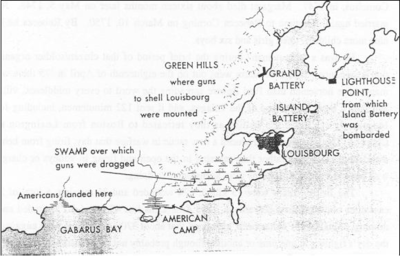
The threat of a combined French and Indigenous attack on New England was realized numerous times by the various Northeast Coast Campaigns (See the Northeast Coast Campaigns 1688, 1703, 1723, 1724). Louisbourg supported these campaigns.
New Englanders' concern increased after a French and Wabanaki Confederacy force sailed from Louisbourg in the summer of 1744 to the nearby British fishing port of Canso, attacking a small fort on Grassy Island and burned it to the ground, taking prisoner 50 English families. This port was used by the New England fishing fleet as it was the closest mainland North American British port to the fishing grounds; however, the Canso Islands (including Grassy Island) were contested by both Britain and France.
The prisoners taken during the Canso raid were first brought to Louisbourg, where they were given freedom to move around. Some of the military men took careful note of the fortress design, layout and condition, as well as the size and condition of its garrison and armaments.[4] These men were eventually released to Boston, where their intelligence, along with that provided by merchants who did business at Louisbourg, proved useful in planning the attack.
The French, military and civilian alike, were not in the best of condition at Louisbourg. Supplies were short in 1744, and the fishermen were reluctant to sail without adequate provisions. The military rank and file claimed that it was promised a share of the spoils from the Canso raid, which had instead gone to officers, who sold those same provisions and profited in the endeavour.[5] In December 1744, the troops mutinied over the poor conditions and pay that was months overdue. Even after acting Governor Louis Du Pont Duchambon managed to quiet the discontent by releasing back pay and supplies, the following winter was extremely tense, as the military leadership maintained a tenuous hold on the situation. Duchambon was even reluctant to send for help, fearing the message would be intercepted and spark further unrest. Word of the unrest did, however, make its way to Boston.[6]
In 1745, the governor of the Province of Massachusetts Bay, William Shirley, secured by a narrow margin the support of the Massachusetts legislature for an attack on the fortress. He and the governor of the Province of New Hampshire, Benning Wentworth, sought the support of other colonies. Connecticut provided 500 troops, New Hampshire 450, Rhode Island a ship, New York ten cannons, and Pennsylvania and New Jersey funds.[7] The force was under the command of William Pepperrell of Kittery (in the portion of the Massachusetts colony that is now the state of Maine), and a fleet of colonial ships was assembled and placed under the command of Captain Edward Tyng. Governor Shirley sent to Commodore Peter Warren, the chief officer of the Royal Navy's West Indies station, a request for naval support in the event of an encounter with French warships, which would significantly outclass any of the colonial ships. Warren at first declined this offer, lacking authorization from London to assist. Only a few days later, he received orders from the Admiralty to proceed to protect the New England fisheries. The expedition set sail from Boston in stages beginning in early March 1745 with 4,200 soldiers and sailors aboard a total of 90 ships.
Battle
Canso and Port Toulouse

The force stopped at Canso to reprovision. There they were met by Commodore Warren, enlarging the expedition by 16 ships. In late March, the naval forces began to blockade Louisbourg, however ice fields were being swept from the Gulf of St. Lawrence to the seas off Louisbourg that spring, presenting a considerable hazard to wooden-hulled sailing ships. The poor weather and general state of disorganization of the New England naval forces resulted in numerous delays to the expedition, however, they kept busy harassing French fishing and shipping in the waters surrounding Île-Royale.
With the ice fields gone by late April, the siege began in earnest. Pepperell's land forces sailed in transports from Canso. On May 2, he besieged Port Toulouse (present-day St. Peter's, Nova Scotia) as well as destroying several coastal villages in the area between Canso and Louisbourg.
Landing

On May 11, John Gorham and his rangers led the charge to land troops on the shores close to the fortress. They tried to land their whale boats at Flat Point Cover while covered by the fire power of the Lord Montague, Boston Packet and Massachusetts. Gorham was repelled by 20 French troops that occupied the cove. Gorham quickly regrouped with several other vessels and the operation was re-directed to Kennington Cove. The French troops were unable to re-position themselves in time to stop the landing of British troops. After 1500 British were already on shore, 200 French troops arrived to repel the British, led by Morpain and De la Boularderie. Morpain retreated while De La Boularderie gave himself up as a prisoner. The British would land 2000 troops by the end of the day.[8]
Destroying the Fisheries
While most of the troops were employed at attacking the Royal Battery, the Island Battery and Fortress Louisbourg, others were scouting around the perimeter of the Fortress, destroying small fishing villages. On May 8, the Mi'kmaq defended against an attack on near-by Margaret's Bay and killed 7 of Warren's troops.[9] On May 11, the English killed or took prisoner 17 French and the French wounded 3 English.[10]
On May 19, Edward Tyng in the vessel Prince of Orange along with the ship Massachusetts destroyed St. Ann's Bay, burning the town and shipping.[11][12] They kill 20 people and taking 25 prisoners. The French killed one British troop.[13] On May 21, the Prince of Orange is joined by the Defense and they destroy Ingonish, burning a town of eighty houses. They continued to destroy the towns of Bradore and Bayonne.[14]
On May 23, 20 British troops from Jeremiah Moulton's Regiment attacked a small village. While they were in the village, they were surrounded by 100 fighters made up of French and Mi'kmaq. They killed 18 of the 20 British troops.[15][16][17]
On May 30, the Mi'kmaq at Chapeau Rouge (L'Ardoise) attacked 13 English soldiers from Captain Fletcher's crew on the Boston Packet, who were seeking wood and water.[18] They killed seven English soldiers, three of whom were scalped. They also took three prisoners, two of whom were later found butchered and one later died of wounds.[19][20]
On June 24, the Defence and the Boston Packet sent a plundering expedition on shore near "Laten."[18]
Royal (Grand) Battery
_by_Peter_Monamy.png)
The French abandoned the Royal Battery and the British were able to take it over and begin to fire at the Fortress.
Island Battery
_by_Peter_Monamy.png)
The Island Battery was the most formidable and took the New Englanders six weeks to silence. The Island Battery, which had 160 troops, needed to be defeated before the Royal Navy could enter the harbour.
On May 26, the 100 British troops under the command of Waldo turned the canons of the Royal Battery on the Island Battery and bombarded the Battery for days.
On June 6, Captain Brooks led 400 British troops against the Island Battery and were repulsed by the French troops. The French killed 60 British troops and took 116 prisoner.[21]
5th failed attack
Later on June 7 Gorham commanded 650 troops to attack but was forced to retreat. The French killed 189 New Englanders in the failed assault.[22][23][24]
On June 9, the 100 British troops fight 100 French and 80 Indigenous. The British killed 40 and took 17 prisoners. The French and Indigenous killed 6 British and wounded many more.[25]
Careening Wharf Battle
Gorham and 40 rangers discovered 30 French canon at the Careening Wharf on June 9. The next day, the French Governor Du Chambon sent 100 inexperienced French troops under the command of Sieur de Beaubassin. Gorham and his rangers were able to launch a surprise attack on the French troops, killing five of them. One of Gorham’s (Indian) rangers was killed.[26][27] (By June 11 (new style), Beaubassins force was decimated with many Mi’kmaw fighters killed.)[28]
Gorham’s Battery
_by_Peter_Monamy_(1681-1749).png)
By June 21 Gorham had built a Battery at Lighthouse Point. He had hauled 10 cannon from the Royal Battery. He shelled the Island Battery for five days and on June 27 the French Battery was silenced.
Surrender
_by_Peter_Monamy.png)
On June 27, French and native reinforcements led by Paul Marin were prevented from reaching Louisbourg in the Naval battle off Tatamagouche.[29] The New Englanders' landward siege was supported by Commodore Warren's fleet and, following 47 days (six weeks and five days) of siege and bombardment, the French capitulated on June 28, 1745.
News of the victory reached Governor Shirley in Boston on July 3 which, coincidentally, was commencement day at Harvard (usually a day of celebration in itself). All of New England celebrated the taking of France's mighty fortress on the Atlantic.
Losses to the New England forces in battle had been modest, although the garrison that occupied the fortress during the following winter suffered many deaths from cold and disease. After the fall of Louisbourg, the New Englanders also assumed control of Port-La-Joye on present-day Prince Edward Island (which the French regained in battle the following year).
Despite the British conquest of Louisbourg, the French and Wabanaki Confederacy attacks continued on Northern New England in the campaigns of 1745, 1746, and 1747).
Duchambon's actions in the mutiny and siege were the subject of inquiries upon his return to France in August 1745. Duchambon was protected from reprisals by the actions of François Bigot, Louisbourg's civilian administrator, who deflected much of the blame onto others. Duchambon retired from the service with a pension in March 1746.
William Pepperrell and Peter Warren were both richly rewarded for their efforts. Warren, in addition to profiting from prize money, was promoted to rear admiral. Pepperrell was made a baronet by King George II and given a commission as colonel of a new regiment, numbered 66th at the time (but not to be confused with the later 66th Regiment of Foot). Governor Shirley was also given a colonel's commission to raise his own regiment.
Both France and Britain planned expeditions to North America in the wake of the capture. The great Duc d'Anville Expedition led by Admiral Jean-Batiste, De Roye de la Rochefoucauld, Duc d'Anville was dispatched from France to retake Louisbourg and recover Acadia in 1746. However it was destroyed by storms, disease and British naval attacks and never reached the fortress. The British government made plans, based on suggestions by Shirley and Warren, for a follow-up expedition to seize Quebec. For a variety of reasons, including a late start and contrary winds, the 1746 expedition did not leave European waters, and was instead diverted to raid the French port of Lorient. Although the idea was also considered for the 1747 campaign season, it again failed to bear fruit.
When the war ended with the signing of the Treaty of Aix-la-Chapelle in 1748, Louisbourg was returned to France in exchange for the return of Madras to Britain, and the withdrawal of French troops from the Low Countries. The decision to withdraw from Louisbourg came under fierce attacks in London from opponents of the Pelham Ministry, but it went ahead nonetheless. In 1758 the fortress was captured again by the British during the Seven Years' War, this time permanently, as Île-Royale and much of New France was ceded to Britain under the terms of the 1763 Treaty of Paris.
British Officers
_(attributed_to_Joseph_Blackburn)%2C_Yale_University_Art_Gallery.png)
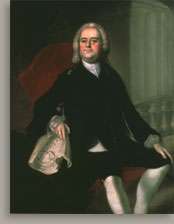 Benjamin Green, d.1772, served on the first Nova Scotia Council in Halifax (1749)
Benjamin Green, d.1772, served on the first Nova Scotia Council in Halifax (1749)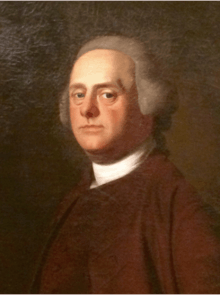 Joseph Gerrish, d.1774; also wounded at the Battle of Grand Pre
Joseph Gerrish, d.1774; also wounded at the Battle of Grand Pre

 Captain Philip Durell, d.1786 (Siege of Louisbourg (1745) and 1758)
Captain Philip Durell, d.1786 (Siege of Louisbourg (1745) and 1758)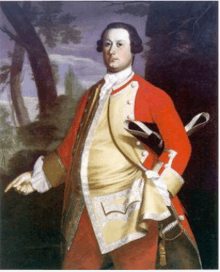
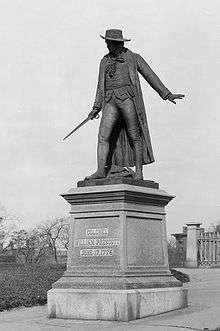


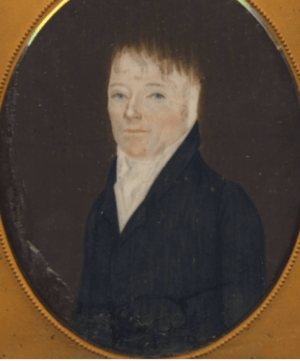
- Richard Jacques (military officer) †
- David Donahew †
- Thomas Westbrook Waldron
- James Gibson (seaman)
- David Wooster
- Samuel Waldo
- Samuel Whittemore
- John Gorham (military officer)
- John Henry Bastide
- Silvanus Cobb
- Hector Theophilus de Cramahé
- Robert Denison
- Sir Charles Douglas, 1st Baronet
- Bartholomew Green (printer)
- Richard Gridley
- John Hale (British Army officer)
- Robert Hale (doctor)
- Charles Lawrence (British Army officer)
- Jeremiah Moulton
- Abijah Willard
- Arthur Noble
- Robert Prescott
- John Rous
- Samuel Moody[35]
- James Monk (lawyer)[36]
- Beamsley Perkins Glasier[37]
- John Caleff[38]
- William Vaughan (soldier)[39]
- Christopher Aldridge[40]
Legacy
- Louisburg Square in Boston is named after the siege.
- Vernon Street, Halifax, Nova Scotia was formerly known as Louisbourg Street.
- Shirley Street, Halifax, Nova Scotia is named for Massachusetts Governor William Shirley.
- Pepperell, Massachusetts and Pepperell Street, Halifax, Nova Scotia were named after William Pepperrell.
- Warren, Rhode Island was named after British naval hero Admiral Sir Peter Warren.
Gallery
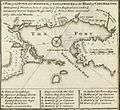 Map of the siege of Louisbourg, 1745.
Map of the siege of Louisbourg, 1745. The Capture of Louisburg, 28 June 1745
The Capture of Louisburg, 28 June 1745 Commanded by Tyng - Massachusetts (frigate), Flagship for Siege of Louisbourg, 1745[41]
Commanded by Tyng - Massachusetts (frigate), Flagship for Siege of Louisbourg, 1745[41]
See also
References
- ↑ Dates are New Style; contemporary British colonial accounts record the siege as occurring 30 April – 16 June in the Old Style.
- 1 2 p. 30
- ↑ Parkman, Francis. France and England in North America
- ↑ Downey, p. 48
- ↑ Downey, pp. 48-51
- ↑ Downey, p. 52
- ↑ Downey, p. 57
- ↑ Rawlyk, p. 41
- ↑ Bradstreet Journal, April 26, 1745 (Old Time).
- ↑ Bradstreet journal, April 30, 1745 (Old Time).
- ↑ p. 79
- ↑ p.85
- ↑ Bidwell Journal, May 7, 1745 (old style). He indicated 20 houses and 20 shallops destroyed and the ship Prince of George taking a man, woman and child prisoner. Also see First Anonymous Journal, Louisburg Journals, p. 15
- ↑ p. 79 (note the author indicates May 9 (old style)
- ↑ "First Anonymous Journal". Louisburg Journals. p. 15.
- ↑ On May 25 (May 13 Old Time), Bidwell indicates that the Indians killed 17 British.
- ↑ 5th Journal. Louisbourg Journals. May 10 (old time). Indicates two escaped. Those who surrendered were butchered. (p. 76)
- 1 2 p. 81
- ↑ Bidwell's journal records the May 18 (old time) incident on May 20. The first annoymous journal records the incident on May 22.
- ↑ 5th Journal. Louisbourg Journals. May 20 (old style) - Indians kill 8 British and take 3 prisoner.
- ↑ 4 Journal. Louisbourg Journals, p. 71
- ↑ 1st Journal, Louisbourg Journals. May 26, 1745 (old style)
- ↑ Louisbourg Journal, p. 22 (footnote); Rawlyk indicates 60 killed
- ↑ Bradstreet indicates the French killed 81 and took 130 prisoners. English killed on French officer and 2 soldiers. Louisbourg Journals, p. 175
- ↑ Wolcott Journal, May 30, 1745 (old time) reporting on an incident that happened May 28 (old time); 1st anonymous journal. Louisbourg Journals. May 30 (old time); 1st Journal May 31 (old style) reports British killed 30 and wounded more than 40
- ↑ Rawlyk, p. 119 indicates May 27 (New Style)
- ↑ First anonymous journal indicates 6 British killed; many wounded; 30 French/ Indians killed, 40 plus wounded (journal 1)
- ↑ Rawlyk, p. 133
- ↑ Patterson, Frank. The History of Tatamagouch. pp. 17–18.
- ↑ p. 464
- ↑ A SERMON OCCASIONED BY THE MUCH LAMENTED DEATH OF COL. MOSES TITCOMB, WHO FELL IN THE BATTLE NEAR LAKE GEORGE, SEPTEMBER 8th, 1755.
- ↑ Biographical Sketches of Loyalists of the American Revolution, Volume 3 By Lorenzo Sabine, pp. 320-321
- ↑ "Letter from David Phips to Colonel Jonathan Snelling regarding escort of Governor Hutchinson to Harvard Commencement, 1773 July 12 · Colonial North America at Harvard". colonialnorthamerica.library.harvard.edu. Retrieved 2018-02-06.
- ↑ "The American loyalists : or, Biographical sketches of adherents to the British crown in the war of the revolution, alphabetically arranged, with a preliminary historical essay". archive.org. p. 625. Retrieved 2017-03-10.
- ↑ http://www.biographi.ca/en/bio/moody_samuel_3E.html
- ↑ http://www.biographi.ca/en/bio/monk_james_3E.html
- ↑ http://www.biographi.ca/en/bio/glasier_beamsley_perkins_4E.html
- ↑ http://www.biographi.ca/en/bio/caleff_john_5E.html
- ↑ http://www.biographi.ca/en/bio/vaughan_william_3E.html
- ↑ http://www.biographi.ca/en/bio/aldridge_christopher_1760_3E.html
- ↑ p. 84
Bibliography
Primary sources
- De Forest, Louis Effingham. Louisbourg Journals, 1745. New York: Society of Colonial Wars, 1932.
- Gwyn, Julian, ed. The Royal Navy and North America: The Warren Papers, 1736–1752. London: Naval Records Society, 1973.
- "Letters relating to the Expedition against Cape Breton." Massachusetts Historical Society Collections, 1st Series, I (1792), 3-60.
- Lincoln, Charles Henry, ed. "The Journal of Sir William Pepperrell". American Antiquarian Society Proceedings, New Series, XX (1909–1910), 135–183
- "The Pepperrell Papers". Massachusetts Historical Society Collections, 6th Series, X (1899), 3-565.
- Pepperell's account. An accurate journal and account of the proceedings of the New-England land-forces, during the late expedition against the French settlements on Cape Breton, to the time of the surrender of Louisbourg [microform] : containing a just representation of the transactions and occurrences, and the behaviour of the said forces ... : with a computation of the French fishery on the banks of Newfoundland, Acadia, Cape Breton ... : all sent over, by General Pepperell [i.e. Pepperrell] himself, to his friend Capt. Hen. Stafford, at Exmouth, Devon
- Journal of the Siege of Louisbourg (1745) - written by Benjamin Green for Pepperell
- "Roger Wolcott's Journal at the Siege of Louisbourg, 1745." Connecticut Historical Society Collections, I (1860), 131–160.
- Memoirs of the principal transactions of the last war between the English and French in North America [microform]: from the commencement of it in 1744, to the conclusion of the treaty at Aix la Chapelle: containing in particular an account of the importance of Nova Scotia or Acadie and the island of Cape Breton to both nations (1758)
- Emerson, Diary Kept at the Siege of Louisburg, March 15-August 14, 1745 (1910)
- Anonymous French Letter - only account from the French viewpoint except the official reports
- Bidwell journal
- Bradstreet journal
- John Storer Journal
- Giddings Journal
- Seth Pomeroy's journal
- Curwen's journal, p.11 (includes portrait)
- Benjamin Cleaves Journal
- Benjamin Sterns journal
- Bradstreet's Journal. Three military diaries kept by Groton Soldiers in Different Wars
- Benjamin Craft's journal
- James Gibson
Secondary sources
- Francis Parkman. Capture of Louisbourg by the New England militia, part 1
- Francis Parkman. Capture of Louisbourg by the New England militia, part 3
- B. A. Balcom, "Defending Unama'ki: Mi'kmaw Resistance in Cape Breton, 1745"
- A. A. Balcom. "the Mi'kmaq and the First Siege of Louisbourg, 1745," Paper presented at the 2003 Spring Heritage Conference, Amherst, Nova Scotia
- Anderson, M.S. The War of Austrian Succession, 1740-1748. New York: Longman, 1995.
- Burrage, Henry S., Maine at Louisburg (sic), (Burleigh & Flynt, Augusta, 1910)
- Roll of New Hampshire men at Louisburg, Cape Breton, 1745 (1896)
- Downey, Fairfax. Louisbourg: Key to a Continent. Englewood Cliffs, NJ: Prentice-Hall, 1965.
- Drake, Samuel Adams. The Taking of Louisburg 1745. Boston: 1891. (Reprinted by Kessinger Publishing, 2007.)
- McLennan, J.S (2000, originally 1918). Louisbourg: From its Foundation to its Fall, 1713–1758. Halifax: The Book Room Limited.
- Rawlyk, G.A. Yankees at Louisbourg. Orono: University of Maine Press, 1967.
- Parkman, Francis, France and England in North America Part 6, A Half-Century of Conflict (Vol. II), (Boston, Little Brown and Company 1897).
- Sosin, Jack M. "Louisbourg and the Peace of Aix-la-Chapelle, 1748". The William and Mary Quarterly, 3rd Series, Vol. 14, No. 4 (October 1957), 516–535.
- Besieged: 100 great sieges from Jericho to Sarajevo
External links
| Wikimedia Commons has media related to Siege of Louisbourg (1745). |
- The Daily Journals, Diaries, Letters, and Accounts of Louisbourg and Isle Royale (1713-1768)
- Louisbourg Under Siege, a National Film Board of Canada documentary
- London Gazette, details of the French surrender at Louisbourg
